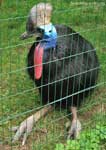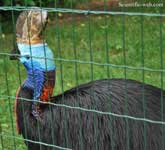Casuarius casuarius, Photo Michael Lahanas
The Southern Cassowary, Casuarius casuarius, also known as Double-wattled Cassowary or Two-wattled Cassowary, is a large flightless black bird with hard and stiff plumage, a brown casque, blue face and neck, red nape and two red wattles hanging down its throat. The three-toed feet are thick and powerful, equipped with a lethal dagger-like claw on the inner toe. The plumage is sexually monomorphic, but the female is dominant and larger with a longer casque and brighter-colored bare parts. The immature bird has plain brown plumage. It is the largest member of the Cassowary family and is the second heaviest bird on earth, at a maximum size estimated at 85 kg (187 lb) and 190 cm (74 in). Normally this species ranges from 127 to 170 cm (50-67 in), with females averaging 58 kg (128 lb) and males averaging 33 kg (73 lb).[2] The Southern Cassowary is distributed in tropical rainforests of Aru and Seram Islands of Indonesia, New Guinea and northeastern Australia. It is technicially the largest Asian bird (since the extinction of the Arabian Ostrich) and the largest Australian bird (though the Emu may be slightly taller). It forages on the forest floor for fallen fruit. The Southern Cassowary was first described by Linnaeus in his 18th century work, Systema Naturae, as Struthio casuarius.[3] It is now the type species of the genus Casuarius. The Southern Cassowary is a solitary bird, that pairs only in breeding season, which takes place in late winter or spring. The male builds a nest on the ground; a mattress of herbaceous plant material 5–10 cm (2–4 in) thick and up to 100 cm (40 in) wide. This is thick enough to let moisture drain away from the eggs. It is situated in a sheltered area among tall grass or similar cover. He also incubates the eggs and raises the chicks. A clutch of three or four eggs are laid measuring 138 mm x 95 mm. They have a granulated surface and are initially bright pea-green in colour though fade with age.[4] Due to ongoing habitat loss, limited range and overhunting in some areas, the Southern Cassowary is evaluated as Vulnerable on the IUCN Red List of Threatened Species.[1] Phylogeny Cassowaries, of the family Casuariidae, are closely related to the various Kiwi birds in the family Apterygidae, with these two bird species diverging from a common ancestor 40 million years ago. The Southern Cassowary is in the class Aves, which includes all birds; those that can fly as well as those that cannot. The Aves, and thus the Southern Cassowary, share a common ancestor with snakes, lizards, iguanas and crocodiles. They aren't very closely related however with the common ancestor's divergence dating back 251 million years ago. [5] Homologous Features Although Cassowaries cannot fly, the structure of their vestigial wings are homologous to the forearms of all pentadactyl animals. These animals include birds of flight, bats, whales and even humans. All of these animal's upper limbs feature the same basic bone structure as that of a Cassowary's wing. Even though the functions are completely different, the similarities of these structures are evidence that all of these animals have evolved from a common ancestor at some stage. These homologous structures, as well as homologous features in other animals, are the result of divergent evolution also known as adaptive divergence. Analogous Features The hardened crest on a Cassowary's head is analogous to the horn of a Rhinoceros. Although it's a rare occurrence, the Cassowary has been known to use this crest as a weapon when agitated, just as a Rhinoceros would use its horn. Although these two animals are not closely related to each other, they have independently evolved similar structures. Analogous structures such as these are the result of convergent evolution. References 1. ^ a b BirdLife International (2008). Casuarius casuarius. 2008 IUCN Red List of Threatened Species. IUCN 2008. Retrieved on 05 November 2008. Database entry includes justification for why this species is vulnerable. * Begon, M, Townsend, C.R, Harper, J.R (2006). Ecology: From Individuals to Ecosystems. Pg 16. ISBN: 978-1-4051-1117-1 External links
Retrieved from "http://en.wikipedia.org/"
 |
|
||||||||||||||||||||||||||||||||||||



